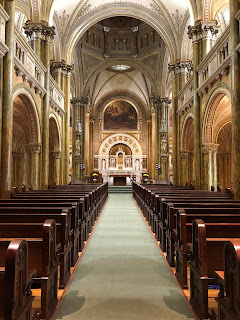After two nights in Prairie du Chien's Motel Six (Oh, boy! Do we ever miss the bed in the RV! But we've got to stay within our budget even if it means a couple nights in less than desirable accommodations. Did I mention the police who knocked on our door in the middle of the night? They were responding to a 911 call made from the motel. Such an adventure! But back to my point), we crossed the bridge to its sister city, Marquette, Iowa, to travel through the Driftless Area in the northeast corner of that state.
The Driftless Education and Visitors Center where we stopped in Lansing describes the terrain this way: "Can you imagine this landscape at the bottom of an ocean? Or as the only dry land surrounded by a sea of ice? These geologic events shaped the Driftless Area long ago, and each dramatic epoch left its mark on the land. Their legacy is this hilly landscape built from soluble rocks like limestone. Geologists call this karst topography. In Iowa, we call it The Driftless."
Up early due to a less than restful night, Tim and I arrived at the center at 8 a.m. just as the wildlife ranger was unlocking the door.
His assistant was absorbed in feeding the amphibians and snakes in their terrariums so we spent a quiet hour there learning about the ecology of the area, especially the conservation efforts of the wildlife service to replenish the freshwater fish and mussel populations.
 |
| Photo on display at the Driftless Education & Visitors Center |
I was also interested in the exhibit about local farming techniques. To keep harmful pesticides and sediment from washing into local waterways that drain into the Mississippi, farmers have left natural buffers, small tracts of land with permanent vegetation, to serve as filters. We saw these as we drove to Lansing. Such buffers reduce the migration of pesticides and herbicides by half.
After climbing Mount Hosmer to another scenic view of the Mississippi, we drove across the Black Hawk Bridge at Lansing into Wisconsin.
A visit at the Genoa National Fish Hatchery, another Great River Road interpretive center, gave us a first-rate introduction to more than two dozen species of freshwater fish the hatchery is attempting to save.
I found it impossible to capture the many ponds where the hatchery is raising the fish.
 |
| Photo courtesy of the Great Road Interpretive Center near Genoa, WI |
This aerial view of the Genoa National Fish Hatchery on display at the center gives a much better view of the scope of the hatchery.
Some of the fish they ship considerable distances. For example, the lake sturgeon they raise here are sent to stock streams from New York to Tennessee while the Higgins' Eye Pearlymussels (isn't that a great name?) go as far south as Gainesville, Florida.
 |
| Charles Bird King, Sauk Chief Makataimeshekiakiah or Black Hawk, 1837, Public Domain |
Besides its obvious mission to educate the public about aquatic wildlife, it also has an excellent exhibit regarding the Battle of Bad Axe, the final battle of the Black Hawk War fought in 1832.
 |
| Map courtesy of the Genoa National Fish Hatchery Interpretive Center |
This battle, if you can call it that, occurred just south of the hatchery. It's another tale of broken treaties that led to the wholesale slaughter of almost all Black Hawk's band.
Then it was on to La Crosse, Wisconsin, where our attention shifted from the environment and the Black Hawk War to Catholicism. At the Shrine of Our Lady of Guadalupe, we joined other visitors in a pilgrimage to the Shrine Church which was constructed in 2004.
Along the way, we stepped into the Mother of Good Counsel Chapel.
Beautiful stained glass windows on three sides of the chapel formed a semi-circle around this pyramid of lit votive candles.
Statues like this one of Saint Joseph the Workman, a tribute to the earthly carpenter father of Jesus, drew our notice as we continued to climb.
When we reached the Shrine Church, we learned that a celebration of mass was in process so we hiked up to the Stations of the Cross.
The bronze relief sculptures like this one of Pontius Pilate washing his hands after questioning Jesus were especially moving to me.
 |
| The Shrine Church of Our Lady of Guadalope |
By the time we returned to the church, the service had ended and a tour guide welcomed us to join him for a closer look at its architecture and ornamentation.
That was not the only church we visited in La Crosse. Later in the day, we stopped at the beautiful Mary of the Angels Chapel on the grounds of St. Rose Convent, the motherhouse of the Franciscan Sisters of Perpetual Adoration.
 |
| Mary of the Angels Chapel |
Since August 1, 1878, at least two sisters have maintained a 24-hour vigil here to pray for the Church, the community and the world. This group of nuns have contributed so much to the city in the arenas of health care, social welfare and education.
The order opened St. Francis Hospital in 1883, now the Mayo Clinic Health System--Franciscan Healthcare in La Crosse.
In 1890 the sisters began St. Rose Normal School to prepare sisters to teach in elementary schools. Today it's known as Viterbo University, a Catholic liberal arts university.
So in less than eight hours we went from being driftless in Iowa to examining the roots of Catholicism in La Crosse, all in a day's trip on The Great River Road.

















No comments:
Post a Comment